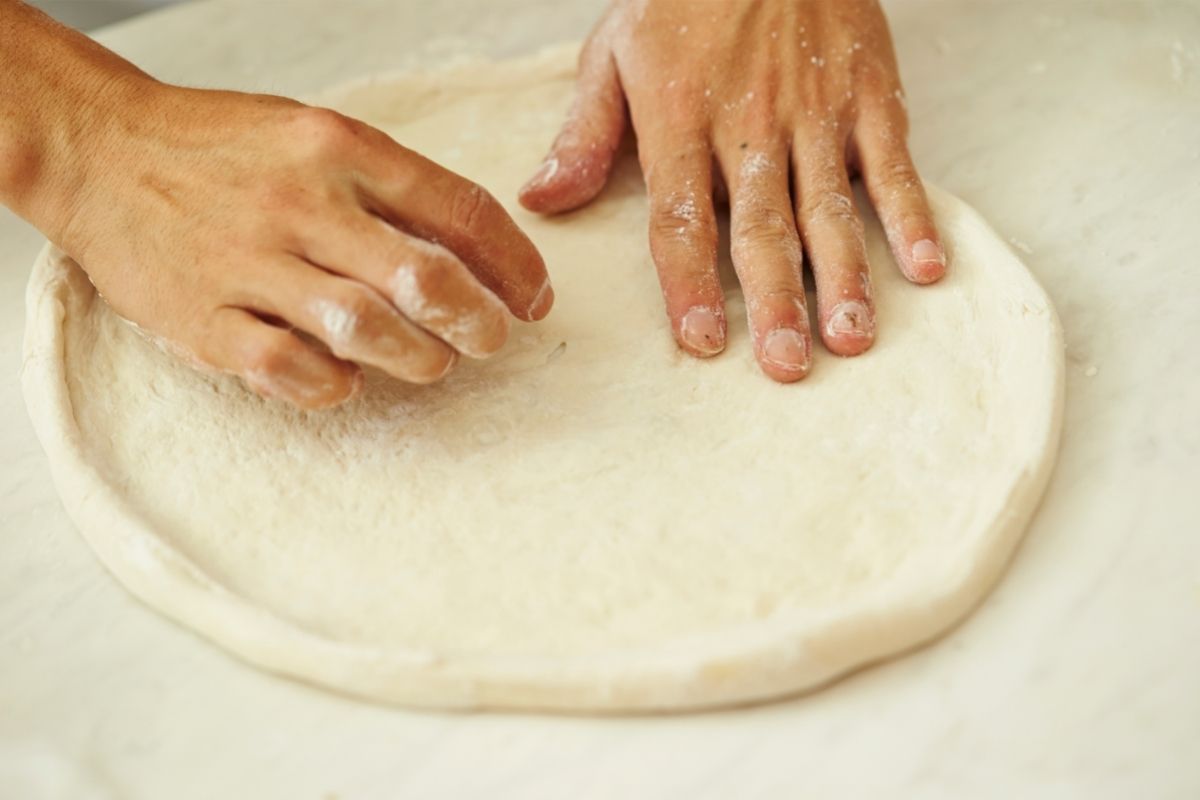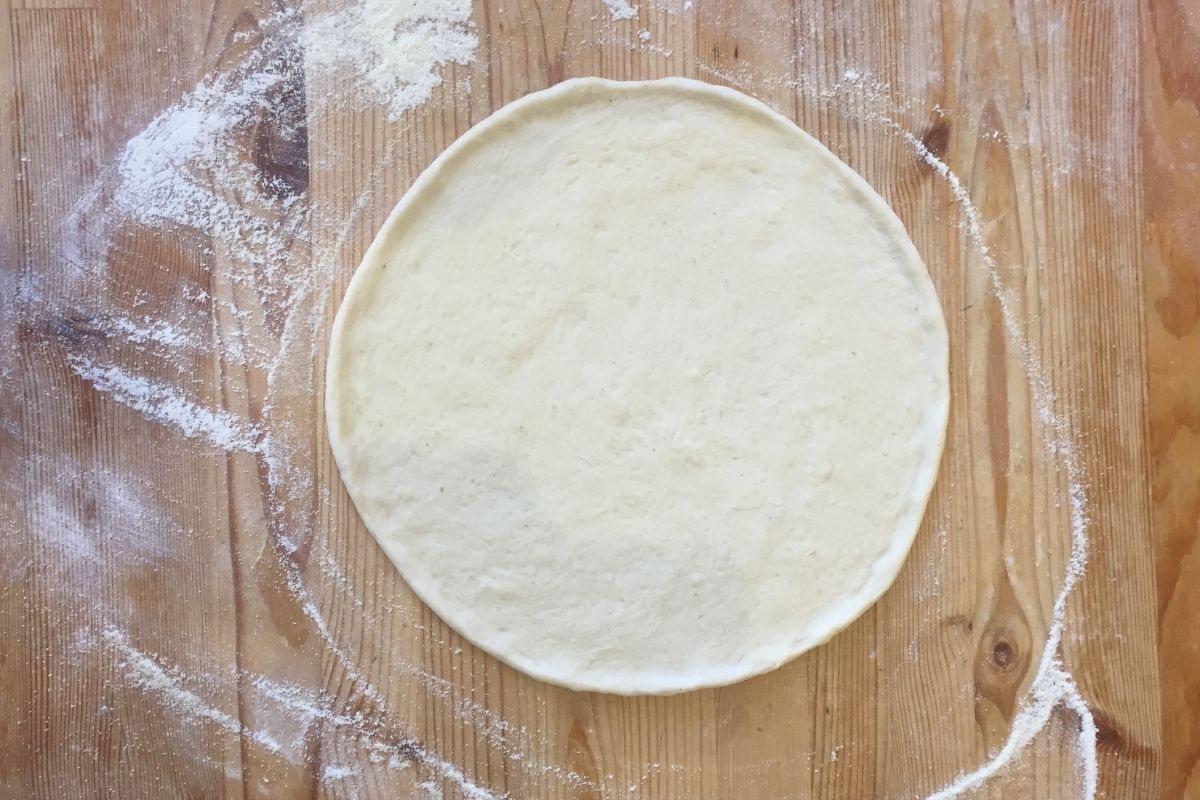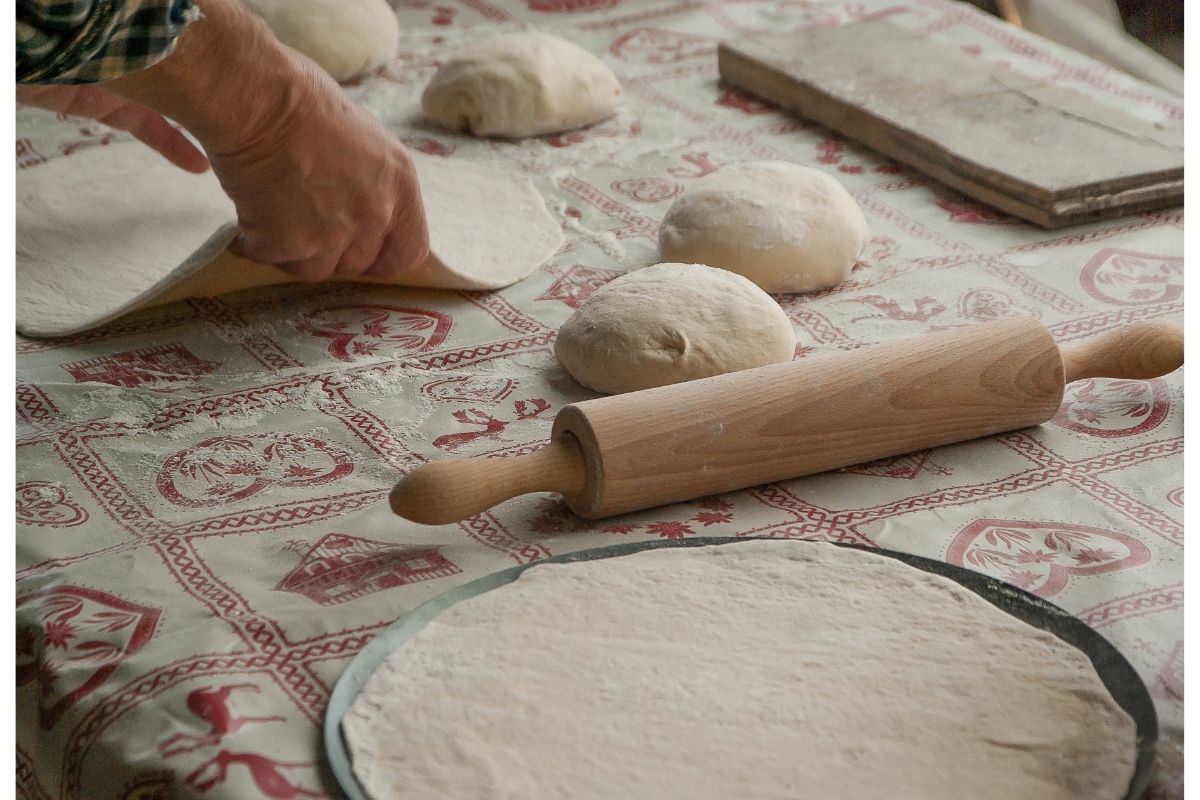Italian Pizza Dough
Pizza dough is a base for your favorite pizza, but does pizza dough have eggs? Egg and milk were not ingredients in the traditional Italian pizza dough recipe. How does it taste?
Are you interested in learning more about this secret? Then, read on to discover the secret behind these tastes.

Is Pizza Crust Vegan?
Vegan cheeses, including vegan parmesan, and meat substitutes such as Beyond Meat crumbles are becoming more common on pizza. Although not all pizza sauces are vegan, the majority of them are. But there’s one more thing to think about: the dough may not be vegan, as many pizza dough recipes contain dairy and other animal products.
Most pizza dough recipes fall into the “vegan” category.
It is dependent on the chain or manufacturer that makes your pizza dough. In general, you shouldn’t assume those doughs are vegan-friendly, but if you’re willing to take the chance, you have those possibilities.
Once you’ve found a vegan dough that you like, pile on the vegetables (red onion, mushrooms, etc.), top with vegan cheese, and finish with vegan parmesan or spices (garlic powder, chili flakes) if they’re available.
Does Pizza Dough Have Dairy?
Is there milk in pizza dough? The majority of pizza dough is dairy-free. It consists of flour, yeast, water, salt, and sugar. Some pizza doughs have eggs in them. If you have allergies or want to avoid eggs, it’s best to double-check the ingredients or contact the manufacturer.
The traditional Italian pizza dough recipe does not include egg or milk; instead, flour, salt, sugar, water, and yeast are the five main ingredients. The good news is that pizza dough is one of the best recipes for anyone with a dairy allergy because it contains no milk, butter, or other animal products, making it ideal for a vegan diet.
Some people use olive oil in their dough, but it isn’t essential. So this settles the question of whether there are eggs in pizza dough.
Does Pizza Dough Contain Gluten?
Pizza dough typically has gluten-containing, all-purpose, barley, or wheat flour. However, you can make gluten-free pizza dough with a gluten-free flour such as almond or oat flour.
It’s crucial to keep in mind, though, that some pizza restaurants and frozen pizza producers may use different ingredients in their pizza dough recipes. As a result, it’s critical that you carefully check the allergen information to ensure that the pizza dough won’t affect you.
Furthermore, the toppings are a different story, so double-check this section of the recipe and see what’s in the pizza sauce as well.
What is the Sugar Content in Pizza Dough?
Sugar isn’t present in all pizza dough. To tenderize the dough and help it rise, add between a 1/2 tablespoon and one tablespoon of sugar. The sugar browns the crust nicely as well. Although pizza may appear to be savory, most pieces include sugar.
Sugar is used in many pizza dough recipes to help the dough rise by reacting with the yeast. Sugar is also added to your slice by the sauce. One strategy to safeguard your heart’s health and lower your chance of gaining weight is to limit your sugar intake.
A slice of frozen cheese pizza has roughly 0.2 ounces (5 grams) of sugar. A typical pizza with meat, such as pepperoni or sausage, contains closer to 0.2 ounces (6 grams) of protein. Pizza sauce is one of the culprits, with up to 0.04 ounces (1.1 grams) of added sugar per 1/4-cup serving.

Alternatives to Traditional Pizza Dough
Portobello Mushrooms
Use Portobello mushrooms as an alternative to traditional pizza dough for your pizza base. On the potassium front, a single Portobello outperforms bananas. Potassium is an electrolyte that plays a vital function in hydration in our muscles and tissues and muscular health and recovery.
These Portobello bases can have toppings such as cherry tomatoes, mozzarella, and a sweet but sour balsamic sauce after being drizzled with a garlic herb oil.
Cauliflower
Cauliflower is the undisputed king of alternative pizza crusts. This white vegetarian miracle is light and crispy, with a thin-crust pizza-like bite. You’ll only need cauliflower, cheese, an egg, and a variety of herbs to prepare it! Drain all of the water from the cauliflower before mixing to avoid a soggy crust.
Quinoa
This quinoa crust will help you get more protein. In addition to containing all eight essential amino acids, quinoa is high in nutrients such as zinc, calcium, iron, riboflavin, heart-healthy lipids, and anti-inflammatory antioxidants.
If you didn’t think it could get any better, wait till you hear this: to make it, you’ll only need five simple ingredients. Quinoa, water, salt, baking powder, and oil are all used in this recipe. So you no longer need to order pizza delivery to satisfy your late-night pizza desire.
Sweet Potatoes
Furthermore, apple cider vinegar is an ingredient for sweet potato crusts. Apple cider vinegar, mainly acetic acid, has been demonstrated to decrease the release of sugar into the circulation and delay gastric emptying. That means you’ll feel fuller and have more energy than you would with a regular pie.
Spaghetti Squash
Spaghetti squash bases are delicious, even if they aren’t like traditional thin crust pizza.
When you use spaghetti squash instead of dough, your crust will not only have a lower glycemic index, which will help keep your blood sugar levels stable, but it will also have more micronutrients like vitamin A folic acid and potassium than bleached white flour.
Lentils
Lentils are popular because of their high nutrient content, low cost, and adaptability. No other food group is in diverse recipes, from brownies and pastries to vegetable burgers and dips like lentils are. You may now add pizza to the list.
Each of these pizzas has around 1/2 cup of red lentils, high in protein, iron, copper, manganese, and folate, a B vitamin that aids memory performance. It will also provide you with a third of your daily fiber requirement.
According to research published in the Annals of Internal Medicine, merely increasing the amount of fiber in your diet will help you lose weight. All you have to do is combine the lentils, water, garlic, and seasonings in a blender, and then sauté it in a pan.
Zucchini
Zucchini will now take the place of your pizza, just as zoodles did before. This dish isn’t utterly flourless because zucchini gets blended with almond flour, but we’ll count it because it is light years ahead of wheat flour. In addition, almonds are abundant in calcium, which helps the body burn fat more efficiently and store it less.
They’re also high in magnesium, a mineral that aids in the growth of lean muscle mass and increases lipolysis (a process by which your body releases fat from its stores). What about zucchini? Potassium, folate, vitamin C, and eye-protecting vitamin A are abundant in this fruit.
Eggplant
You can make a pizza out of any vegetable by simply topping it with cheese and tomato sauce, but eggplants are one of the most delicious options. This is because eggplants are high in chlorogenic acid, a phenol antioxidant that scavenges disease-fighting free radicals, in addition to being meaty and satisfying.
Simply brush the aubergines with olive oil on both sides before grilling them over medium heat. After the meat has gets cooked, add your toppings and bake!
Plantain
What about the crust? All you need is plantain, an egg, and seasoning. You probably didn’t realize that making pizza at home could be easy. We’d easily mistake this plantain-based pizza for a regular pizza.
Choose the least ripe fruit for the pie because it will have a neutral flavor rather than sweet. Plantains, shaped like bananas but are more like starchy potatoes than sweet, have more than twice the amount of immune-boosting vitamin C as their banana counterparts.
Chickpeas
This socca pizza gets topped with Mediterranean tastes like feta, sun-dried tomatoes, olives, and zucchini. Socca is a traditional Greek pancake made with chickpeas instead of white flour, increasing protein and fiber content.
While you can buy chickpea flour in supermarkets, you can make your own by crushing dry chickpeas in your blender. First, blend until the flour is as finely ground as possible, and then sift it into a bowl through a sieve.
Beets
Who knew that eating pizza may help you perform better in sports? But, if you make this, that’s what will happen to you! According to a study conducted at Kansas State University, it has beetroot, a vegetable that improves blood flow to muscles, particularly “fast-twitch” muscles that affect bursts of speed and strength.
Another study published in the Journal of the Academy of Nutrition and Dietetics found that runners who ate baked beets before a 5K raced 5% faster, owing to the beets’ nitrates.
This natural molecule boosts endurance and reduces blood pressure. For added benefits, replace the flour in the recipe with any gluten-free flour such as chickpea flour, almond flour, or coconut flour.

Conclusion
It’s crucial to know what’s in your pizza dough, whether you’re making your own or buying pre-made pizza dough. Baked items, such as pizza dough crust, can be challenging for people who don’t eat eggs or milk.
The good news is that pizza dough requires flour, yeast, water, salt, sugar, and a small amount of olive oil, which is optional. Any cookbook will tell you that spraying the dough with olive oil before placing it on a baking pan to be baked is a good idea, although some pizza places may use egg instead, so check if you’re eating out.
Do pizzas have eggs? You may find eggs, milk, and other unusual ingredients in some frozen pizzas. Naturally, the crust will turn out differently when utilizing these, but it’s preferable to keep to the conventional bread dough recipe.
You have the right to ask what’s in your pizza dough, and you should get in the habit of doing so to guarantee that your pizza dough is always what you anticipate, whether you enjoy egg pizza crusts or favor almond flour pizza crust without eggs. You will always have a choice.

Community of passionate writers and content creators who share a love for Italian heritage, culture, travel, food, and the Italian-American community. Our mission is to celebrate Italy’s rich history and traditions and connect with others who share the same passion.

